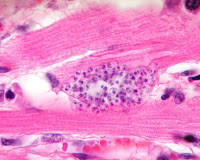Answer:
Typanosoma cruzi amastigotes
. This intracellular collection of
T. cruzi amastigotes is referred to as a 'pseudocyst' since there is no true cyst wall.
The location (heart muscle) is useful in making the diagnosis since this is a classic site for
T. cruzi in humans, but it's important to keep in mind that pseudocysts can form in other organs and in skeletal muscle.
The principal differential diagnosis based on this morphologic appearance includes
Histoplasma capsulatum yeasts and
Leishmania amastigotes. Instead of forming a pseudocyst, however, they both reside within macrophages and the collection of organisms will be much smaller.
Congratulations to Tom and Dr. R for getting the correct answer for this case. Tom also added the following for those of you who enjoy learning aids (myself included):
"T cruzi is known for lots of C's.Cruzi
Chagas disease
C-shaped (referring to the tryptomastigote blood stage)
If you want to get a little more Crazy, here are some more:
Cardiac tissue
Central & South America
Cheek swelling near eye (Romana's sign)
Chronic infections are common
Colonic infection (megacolon)
Crap from Reduviid bugs, which contain the trypanosomes, and gets inoculated into the bite wound by scratching."
I would also add in Cysts (pseudocysts), as shown in this case.
















